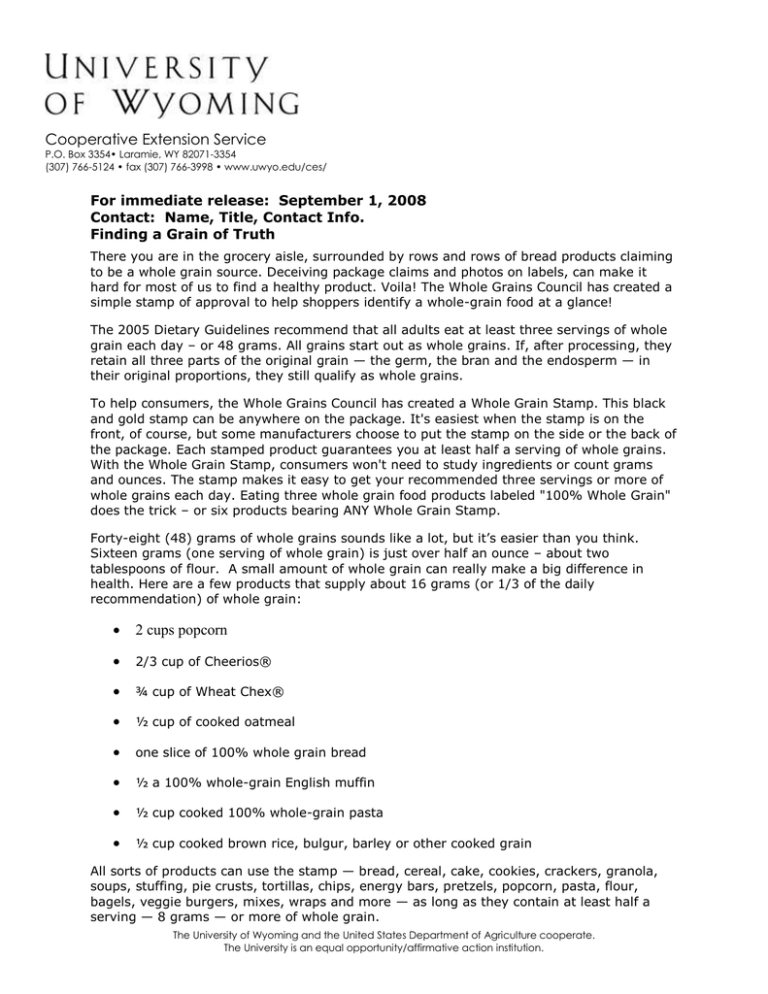Finding a Grain of Truth
advertisement

Cooperative Extension Service P.O. Box 3354• Laramie, WY 82071-3354 (307) 766-5124 • fax (307) 766-3998 • www.uwyo.edu/ces/ For immediate release: September 1, 2008 Contact: Name, Title, Contact Info. Finding a Grain of Truth There you are in the grocery aisle, surrounded by rows and rows of bread products claiming to be a whole grain source. Deceiving package claims and photos on labels, can make it hard for most of us to find a healthy product. Voila! The Whole Grains Council has created a simple stamp of approval to help shoppers identify a whole-grain food at a glance! The 2005 Dietary Guidelines recommend that all adults eat at least three servings of whole grain each day – or 48 grams. All grains start out as whole grains. If, after processing, they retain all three parts of the original grain — the germ, the bran and the endosperm — in their original proportions, they still qualify as whole grains. To help consumers, the Whole Grains Council has created a Whole Grain Stamp. This black and gold stamp can be anywhere on the package. It's easiest when the stamp is on the front, of course, but some manufacturers choose to put the stamp on the side or the back of the package. Each stamped product guarantees you at least half a serving of whole grains. With the Whole Grain Stamp, consumers won't need to study ingredients or count grams and ounces. The stamp makes it easy to get your recommended three servings or more of whole grains each day. Eating three whole grain food products labeled "100% Whole Grain" does the trick – or six products bearing ANY Whole Grain Stamp. Forty-eight (48) grams of whole grains sounds like a lot, but it’s easier than you think. Sixteen grams (one serving of whole grain) is just over half an ounce – about two tablespoons of flour. A small amount of whole grain can really make a big difference in health. Here are a few products that supply about 16 grams (or 1/3 of the daily recommendation) of whole grain: 2 cups popcorn 2/3 cup of Cheerios® ¾ cup of Wheat Chex® ½ cup of cooked oatmeal one slice of 100% whole grain bread ½ a 100% whole-grain English muffin ½ cup cooked 100% whole-grain pasta ½ cup cooked brown rice, bulgur, barley or other cooked grain All sorts of products can use the stamp — bread, cereal, cake, cookies, crackers, granola, soups, stuffing, pie crusts, tortillas, chips, energy bars, pretzels, popcorn, pasta, flour, bagels, veggie burgers, mixes, wraps and more — as long as they contain at least half a serving — 8 grams — or more of whole grain. The University of Wyoming and the United States Department of Agriculture cooperate. The University is an equal opportunity/affirmative action institution. Shopping is much simpler; all you need to do is look for the distinctive black and gold stamp on the packaging. And if you enjoy knowing just how much whole grain is in the products you're eating, the Whole Grain Stamps tell you specifically– while also reminding you to aim for at least 48g of whole grain overall, each day! Trade or brand names used in this publication are used only for the purpose of educational information. The information given herein is supplied with the understanding that no discrimination is intended, and no endorsement information of products by the Cooperative Extension Service is implied. Nor does it imply approval of products to the exclusion of others that also may be suitable. Source: Susan Mills-Gray, Nutrition & Health Education Specialist, University of Missouri Extension. Kara Berrini, Program Manager, Whole Grains Council, Boston, MA 02116 USA, www.wholegrainscouncil.org.



